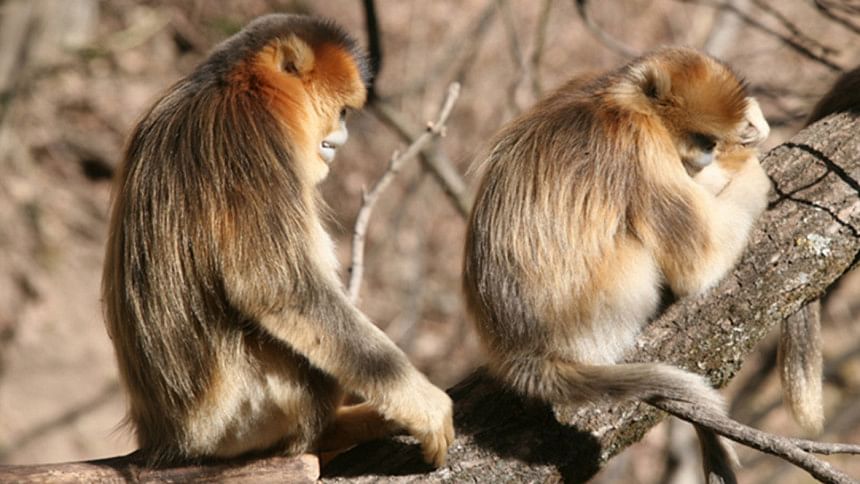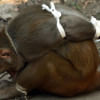Monkey seen caring for dying mate, grieves after she dies

In one of the first examples of compassionate care and grief in a wild monkey, an alpha male of a group of snub-nosed monkeys and his dying partner spent a final, tender hour together before she passed away.
He stayed by her beneath the tree from which she had fallen minutes earlier, cracking her head on a rock, reports New Scientist.com.
According to New Scientist, before she succumbed, he gently touched and groomed her. And after she was dead he remained by her side for 5 minutes, touching her and pulling gently at her hand, as if to try and revive her.
"The case we've reported is particularly important because of the exclusively gentle nature of the interactions, and the special treatment of the dying female shown by the adult male," says James Anderson of Kyoto University, Japan.
"The events suggest that in the case of strongly bonded individuals at least, monkeys may show compassionate behaviour to ailing or dying individuals."
The study follows a recent report of a quasi-funeral for an adult captive chimpanzee at a sanctuary in north-west Zambia, and evidence of death-related behaviour in crows, reports New Scientist.
Together, the reports add to evidence that humans may not be the only species to display grieving behaviour following bereavement, or to show respect for dead individuals with whom they have forged ties.
According to the New Scientist, they also hint that animals have some recognition of the finality of death.
"It seems likely that in long-lived species such as many primates, repeated exposure to death within the group leads to an understanding of the irreversibility of death," says Anderson.
"I believe the adult male and other members of his unit understood the dead female was no longer alive."
Anderson says that while it's dangerous to anthropomorphise, when strong bonds formed between individuals are broken by death, those individuals can feel the impact emotionally.
"It seems quite reasonable to conclude that monkeys and apes may suffer grief in bereavement," he says.
"There's now enough evidence from observations of responses to dying group members in species such as chimpanzees, elephants and dolphins to suggest that empathy and compassion occur in these species, and now in snub-nosed monkeys."
"This report provides compelling evidence that non-human animals experience deep grief and loss," says Marc Bekoff, an ethologist at the University of Colorado, who says he has witnessed similar "grieving ceremonies" in wild coyotes, elephants, dogs, red foxes, cats, crows and magpies.
"As I watched some magpies respond to a dead corpse, I saw them stand around the body, fly away, bring back pine needles to lay around the dead body, softly peck at it, almost imperceptibly bow their heads, then fly off," says Bekoff.
"We don't know exactly what's going on in the heads and hearts of these animals, or whether they have a concept of death that tells them their friend is gone forever, but I don't see any reason at all to say they're not grieving."
Rare reports of primate responses to death are important for our understanding of the evolutionary origins of some "mourning" behaviours, says Edwin van Leeuwen of the University of St Andrews, UK.
Last month, he reported the case of the chimpanzees at the Zambian sanctuary reacting when they discovered a group member dead. The behaviour involved "quiet attendance and close inspections punctuated by rare displays" (see "A chimp funeral for a friend, below").
The origin of, and motivation for, such behaviours remains unknown.
"Is it to console the wounded, the dying, or for reasons that have more to do with a survivor's own well-being, such as reducing anxiety?" van Leeuwen asks.
One important clue, common to both reports, is that the deceased animals were adults who had strong social links with their peers and acquired status within the group, reports New Scientist.
This, according to van Leeuwen, reflects research suggesting that mourning evolved to mark the passing of socially important individuals. The behaviours follow naturally from actions necessary to sustain group cohesion, he says.
Bekoff agrees. "It could be adaptive, by bringing group members together to foster cohesiveness, and they might know that they need to reorganise in the absence of a former group member," he says. "But it's hard to say how each factors in."
Not everyone is convinced. "A hard-nosed approach would be to describe what happened in terms of confusion on the part of the animals closest to this monkey [that] fell out of the tree," says Matthew Cobb at the University of Manchester, UK.
"Attempts to rouse or provoke a sick or dying individual do not necessarily tell us anything about the internal state of the 'caregiver'. The explanation may be much simpler, and less romantic."
Source: New Scientist

 For all latest news, follow The Daily Star's Google News channel.
For all latest news, follow The Daily Star's Google News channel. 








Comments